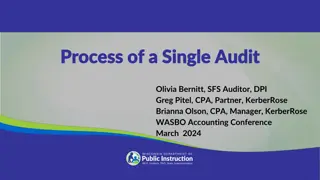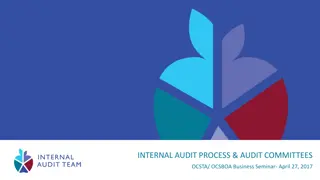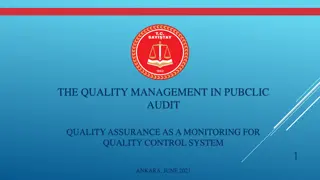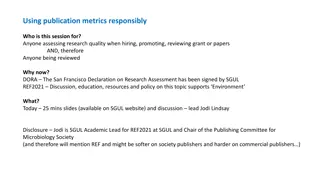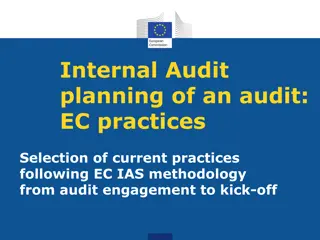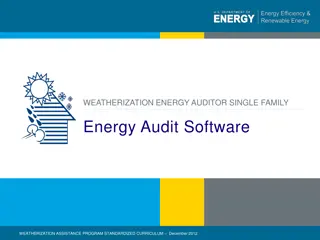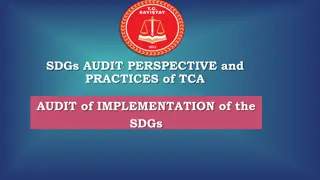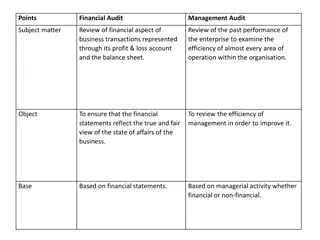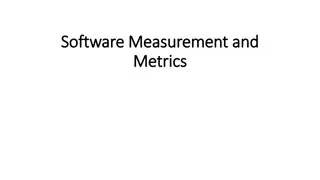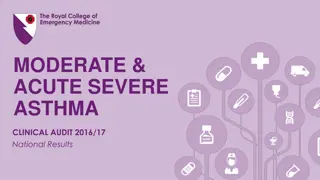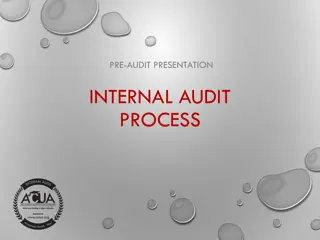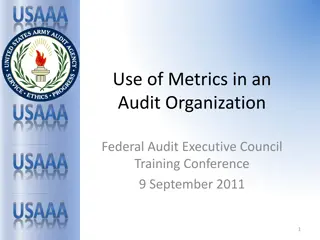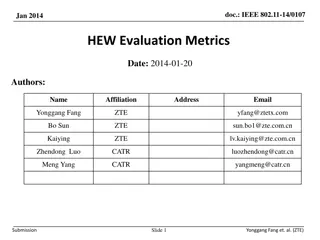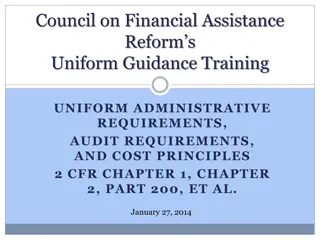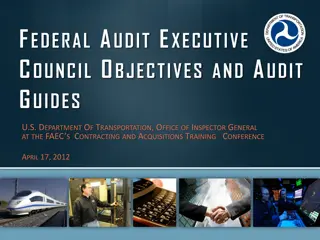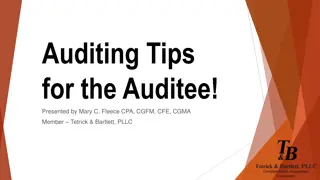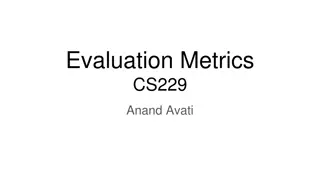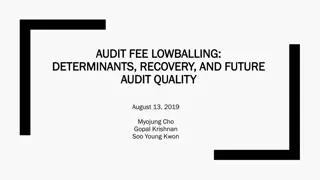Federal Audit Practices and Metrics Evaluation
This content discusses the identification and compilation of internal and external metrics in the Federal audit community, factors in annual audit planning, survey development on internal reporting, external reporting, and annual planning. It also covers objectives of audit practices, feedback received on metrics and performance measures, adopted performance metrics, evaluation of audits in process, and addressing high-risk areas based on agency strategic goals. The content emphasizes the importance of timely findings, actionable recommendations, and adherence to quality assurance guidelines in Federal audits.
Download Presentation

Please find below an Image/Link to download the presentation.
The content on the website is provided AS IS for your information and personal use only. It may not be sold, licensed, or shared on other websites without obtaining consent from the author.If you encounter any issues during the download, it is possible that the publisher has removed the file from their server.
You are allowed to download the files provided on this website for personal or commercial use, subject to the condition that they are used lawfully. All files are the property of their respective owners.
The content on the website is provided AS IS for your information and personal use only. It may not be sold, licensed, or shared on other websites without obtaining consent from the author.
E N D
Presentation Transcript
Audit Policies and Practices Committee
Identify and compile internal and external metrics and performance measures used in the Federal audit community for evaluating audit quality and timeliness. Compile factors and best practices used in annual audit planning. 2
Collaboratively developed survey questions on Internal Reporting 6 questions External Reporting 2 questions Annual Planning 10 questions Solicited input from FAEC community in May 2013 Received responses from 34 Audit organizations. 3
Answers objectives Provides timely findings and actionable recommendations Addresses critical and high-risk areas Adheres to quality assurance guidance (e.g., Yellow Book, internal and peer reviews) Involves client satisfaction surveys to obtain feedback. 4
35 30 25 20 15 10 NA NO YES 5 0 8 metrics and performance measures surveyed Considerable feedback provided 5
YES 30 NO 3 NA 0 Measure Adopted Performance Metrics Draft reports issued within 300 elapsed days Reduction in average elapsed days to deliver final reports compared to prior year Projects completed within one year Percentage 60% 3% 80% Tracked and monitored Included in employee performance standards. 6
YES NO NA Measure Adopted 24 8 1 Internal guide to evaluate audits in process Performance metric and tracking of Timeliness of specific phases Staff workdays Direct time charges Return on investment 7
YES 30 NO 4 NA 0 Measure Adopted Agency strategic goals/priorities GAO high-risk areas IG management challenges Enterprise-level risk assessment Input from senior organizational leaders Annual risk-based program assessments Percentage of planned performance audits address high risk areas 8
Yes 27 No 6 NA 1 Measure Adopted Establish metrics to ensure audits meet statutory mandated deadlines Establish individual performance standards 9
YES 29 NO 3 NA 2 Measure Adopted Reductions, Recoveries, Reallocations Tracks monetary benefits with specific goals Report at least $30M in potential monetary benefits each fiscal year Meet a return on investment goal of at least $10: $1, $8: $1 Ensure 10% of published reports identify potential monetary benefits Ensure 60% of performance audits include recommendations leading to demonstrable cost savings and/or funds put to better use Monitors benefits via management information system Performance metric based on the dollar savings identified during the year. Reviews actual realized benefits during follow-up engagements Reports financial benefits only as a workload measure; no goal 10
YES 27 NO 6 NA 1 Measure Adopted Improved Processes, Procedures, or Controls Monitors recommendation implementation and follows up when implementation has not occurred by target date of completion Discusses audit work in context of organization s qualitative goals Includes corporate goals such as: 70% of past recommendations implemented within two years of the fiscal year in which the report was issued 60% of performance audits should include recommendations leading to demonstrable cost savings, program efficiencies, and/or funds put to better use 11
YES NO NA Measure Adopted Report Issued Within a Specified Number of Days 22 11 1 Information obtained before the report is issued Information tracked via internal management system. All open audit recommendations are discussed monthly with audit resolution officials Metrics established for receipt of comments and actions taken Request comments and recommendation responses within 30 days of the draft report issuance. Achieve a 5-year average implementation rate of 85% for accepted recommendations. Obtain final management decisions and/or target implementation dates within 90 days of report issuance. Write recommendations so organization can complete them within 6-9 months. Receive action plans within 60 day of final report issuance. Report twice a year on all unimplemented recommendations past 6 months of original target date to agency senior leadership. 12
YES 32 NO 2 NA 0 Measure Adopted Weekly exception report for projects that have not met milestones Communicate status of high impact audits during monthly senior management meeting Establishes an estimated amount of audits to complete in the fiscal year Incorporates an organization milestone goal for deliverables Deliver 60% of audits with draft reports within 300 elapsed days Issue reports within 270 days of audit start Complete 80% of projects with a year. Finalize 90% of assignments within 30 days of established final report milestones Finish audits within one year from entrance conference Conclude audits based on audit scope: Standard audit is 11 months from entrance conference to final report; limited scope is 2.5 to 10 months from entrance to final report 13
YES 21 NO 13 NA 0 Measure Adopted Try to do a balanced approach for financial, process efficiency, and program impact, but no formal scorecard 14
YES NO NA Measure Adopted 33 1 0 Total cycle time From initiation to report issuance -- 8 months for non complex audits to 13 months for complex audits. Total elapsed days for each project Contract/Grant audits:5 days on-site & 5 days for survey and report completion. Recommendations concurred with by Agency 80% are accepted Percent of open Recommendations implemented 95% of past recommendations are implemented. Number of Audit reports produced; percentage of reports containing one or more recommendations Financial Benefits & Non financial benefits Return on Investment Percentage of audit completed with established timeframes (90%, 75%) Complete 90% of audits within 15% of established budget and within 30 days of report milestones; 75% of audits address high risk activities 15
YES 32 NO 2 NA 0 Measure Adopted No Furloughs this Fiscal year Money is available for travel and training at a reduced rate. Work plan focused on audits requiring less travel; on track to meet CPE requirements. Additional funding from ARRA and Hurricane Sandy relief. 16
Measure Adopted YES NO NA Staff Professionalism staff training 26 3 3 Value of Service Provided stakeholder survey/feedback; dollar value of recommendations; briefing with Agency leadership; briefing with Congressional staff 26 4 2 Other acceptance of recommendations 13 7 3 17
Measure Adopted YES NO NA Measures Contained in Semi- Annual Report 31 3 0 Additional Measures - timeliness; number of reports issued; percentage of recommendations with management decision/final action; percentage of audits with high risk/management challenges 23 6 2 18
Report Issuance 24 Amounts Agreed to 13 Amounts Agency Agreed to Collect 1 9 report at issuance and agreed to 19
Measures Adopted YES NO NA Linked to OIG strategic goals Linked through cascading objectives/strategies 32 1 1 18 15 1 One associated this with assessing the risk environment to develop risk categories 20
YES 20 NO 13 NA 1 Measure Adopted linked though other metrics Number of intended reviews Timeliness Ratio of requested to internally-generated audits Coverage of Agency priorities/mission Coverage of Management Challenges Coverage of GAO High Risk Areas Amount of Direct Staff time applied to critical and high impact projects Number of reports issued aligned by Management Challenges 21
Measures Adopted OIG goals linked to Department Linked to Agency management challenges Department provides feedback on plan - input, not approval YES 27 NO 4 NA 2 30 2 2 27 6 0 22
Other Factors Considered Congressional or Agency leadership requests, New programs, Audit history and risk with existing programs Follow up on prior recommendations Stakeholder input Risk Assessment Resource Availability Balance of coverage across Agency programs Timing to ensure most value to client 23
Other Factors (cont.) Hotline complaints Large grant recipients/dollar programs OMB A-123 and FMFIA assessments Government-wide initiatives Statutory requirements Media interests/emphasis Special funding allocations (e.g., Recovery Act, Disaster Oversight, etc.) Investigative referrals Impact on the delivery of services and benefits to recipients Public interest 24
Priority 1 2 3 4 Legislation, Executive Order, OMB Circular (i.e., mandatory work)? 30 2 1 0 Specific requests from Department/Agency Leadership? 5 18 8 3 Congressional appropriators or overseers? 16 16 1 1 Self-initiated work? 6 15 8 5 25
Ad Hoc (as needed) 22 Scheduled update 6 Not Typically Modified 6 26
John Needham, SBA Stephen Dingbaum, NRC Terri Alvarado, Army Audit Ann Eilers, Commerce Jane Mintz, Commerce Julie Marlowe, SEC Gil Harden, USDA 27
Questions Thanks for providing information 28



